Contents
What is the Hanoi Train Street?
About four years ago, a photographer named Ashit Desai was very surprised when he discovered a very different aspect of life in the capital city of Vietnam, Hanoi. He followed the railway and went into a very narrow hamlet that the trains pass every day. Lots of houses were built along the hamlet and the distance between houses and the railway is just about four steps, which really means when the train passes, just an outstretched arm can touch the train. When Ashit Desai posted the photos he took of this train street, Western presses were very impressed and people have become curious about how and why our citizens live in such a dangerous place.
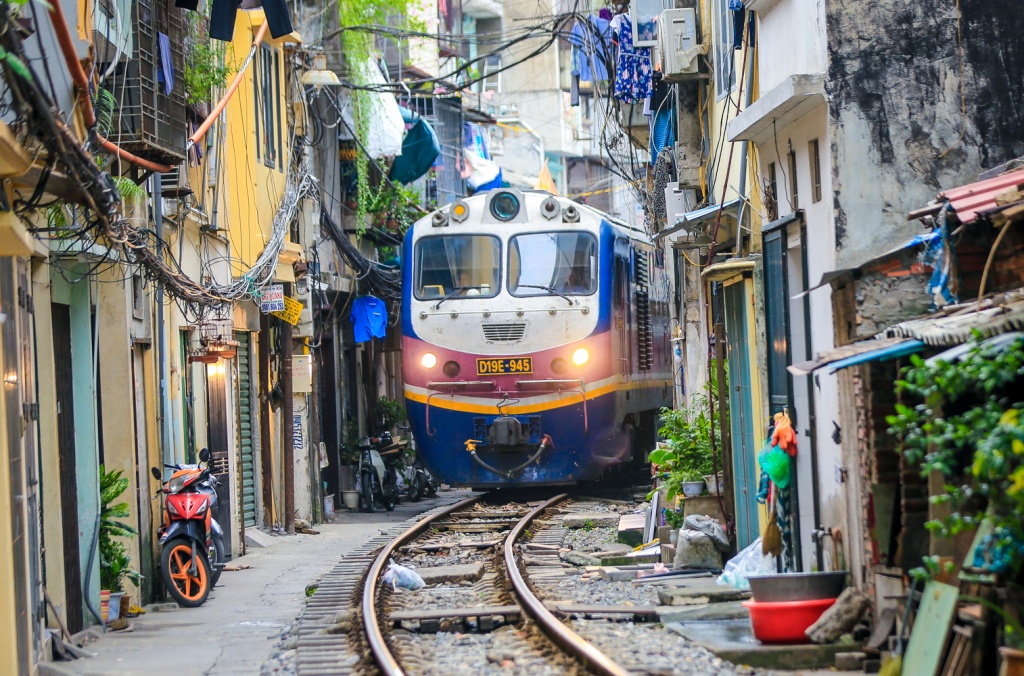
This train street is close to Hanoi Railway Station. More than a hundred years ago, when the French colonized Indochina (including Vietnam, Laos, and Cambodia), Hanoi was chosen as the capital of the French Indochina in 1902. The French built this railway system to transfer passengers and goods to the north with the end point of Lao Cai province.
Time flies, Hanoi has become a developed capital city of Vietnam, in which there are many new modern buildings and newly-constructed, better infrastructure. However, the houses and shops of this train street have hardly changed after a century. People are still living in the old houses three steps away from the railway.
You might actually feel lost in Hanoi of the early 20th century when here, where people live in small old houses and cook their meals outside right next to the lines. According to Hanoi’s authority, this train street belongs to a removing and resettling project, which will help the citizens on this street live in a safer place. The area along the railway will eventually be reconstructed for safety in the near future. Therefore, people do not build new houses, but fix up old ones. From the outside, everything seems frozen in time of a hundred years ago.
Visit the Train Street in Hanoi
My Experience
It was 3 PM when I arrived to this train street with the help of Google Maps. As I was waiting for my local friend who has lived in Hanoi for two years, I started to discover the train street alone first. From number 10, Dien Bien Phu street, I turned onto a small alley where the railway passes separate blocks of houses on two sides. There were a lot of tourists already! Along the wall of the house, people were sitting, having coffee, and chatting. Right on the railway, many people were trying several postures to get the best photo.
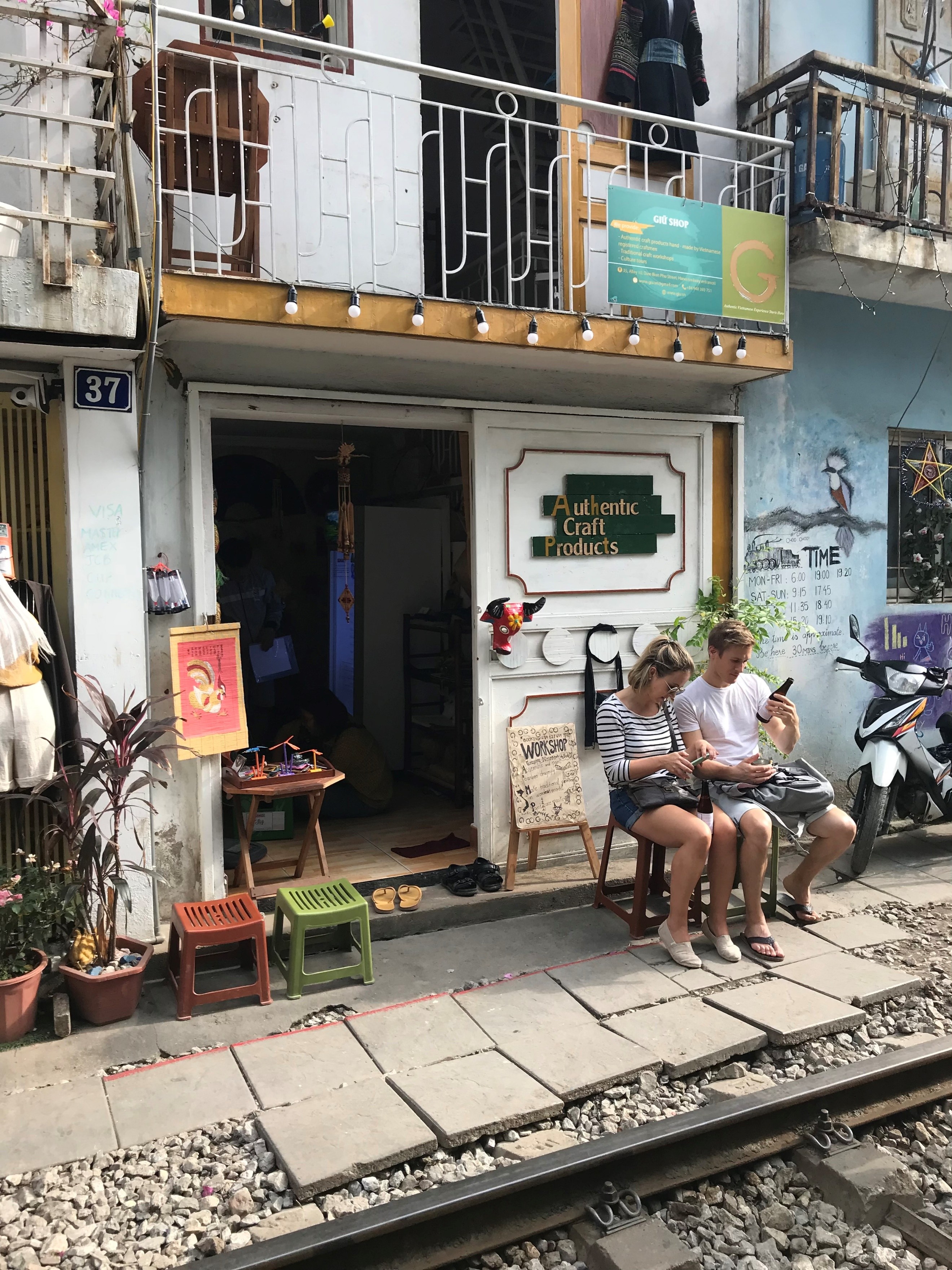
The street was very crowded and active, which contrasted with the old houses. People had several nationalities, from American, European, Korean, Southeast Asian, to Vietnamese. As I had researched before, I knew that this area was once silent because people couldn’t take advantage of their front houses to sell goods. But now, many stores are established: coffee shops, souvenir shops, ao dai shops, and even a nail salon.
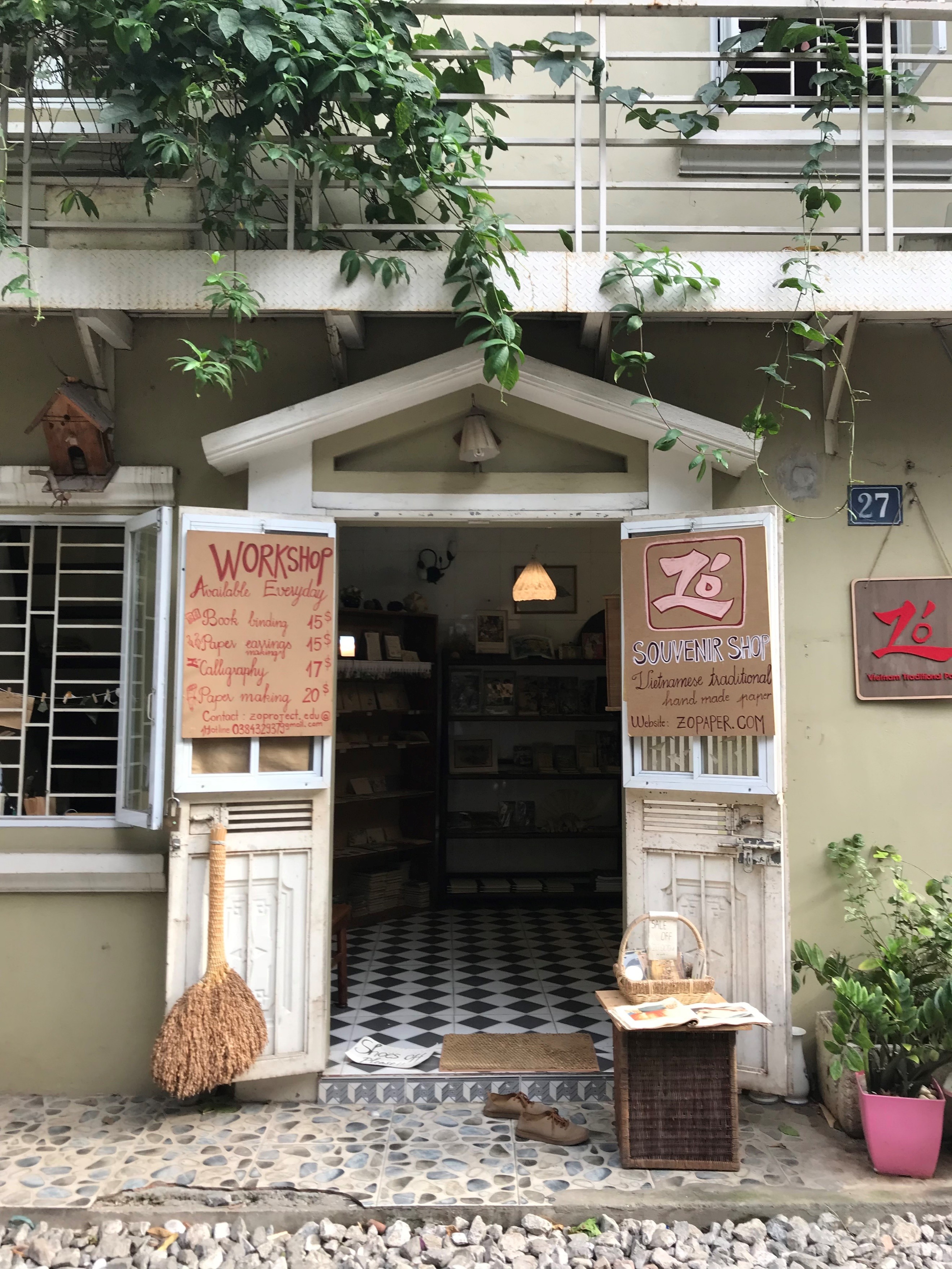
I spotted a young girl from a coffee shop wandering around to greet tourists and invite them to drink coffee and wait for the train. When she saw me, she said welcome to me in Vietnamese and told me that the train would come in just 15 minutes. I thanked her and went to the end of the street. Because the railway crosses the city, you can find a few short train streets like this separated by two main streets. It seemed like this was the most crowded and famous train street, because I recognized tourists from the other train streets gathering.

Walking along the street, I encountered many pans, pots, kettles, and clay stoves in front of the houses. Later on, I even saw a stove set up on the railway, but as I passed, it was moved aside to make room for the train. On the wall and the windows, someone painted cute pictures. There was also a sign written “English class for the elderly in the neighborhood”. Seems like they know how to catch up with the trend.
After that, I went back to a coffee shop named Tram Station and ordered a cup of egg coffee. At first, my position didn’t seem dangerous at all due to the distance, around 1.7 meters from the railway. Why were people so serious about this train street? But I was definitely wrong! At exactly 3:20 PM, I was asked to stand up and stay close to the wall, behind a red line on the ground. People took out their cameras and cell phones, ready to film the upcoming train.
Three minutes later, I heard the horn from the train, and there it was. The train quickly arrived with a loud rumbling sound. When I counted the distance, I forgot that the real train is wider than the railway, so when the train passed me, a sudden blast of air cooled my face, I recognized the distance to be 20 to 30 centimeters. Just a careless step and you could be gone with the train. The coffee shop staff told everyone that this train went from Hanoi Station to Lao Cai Station, where you can easily get to Sapa (for more details about Sapa, please visit this article.
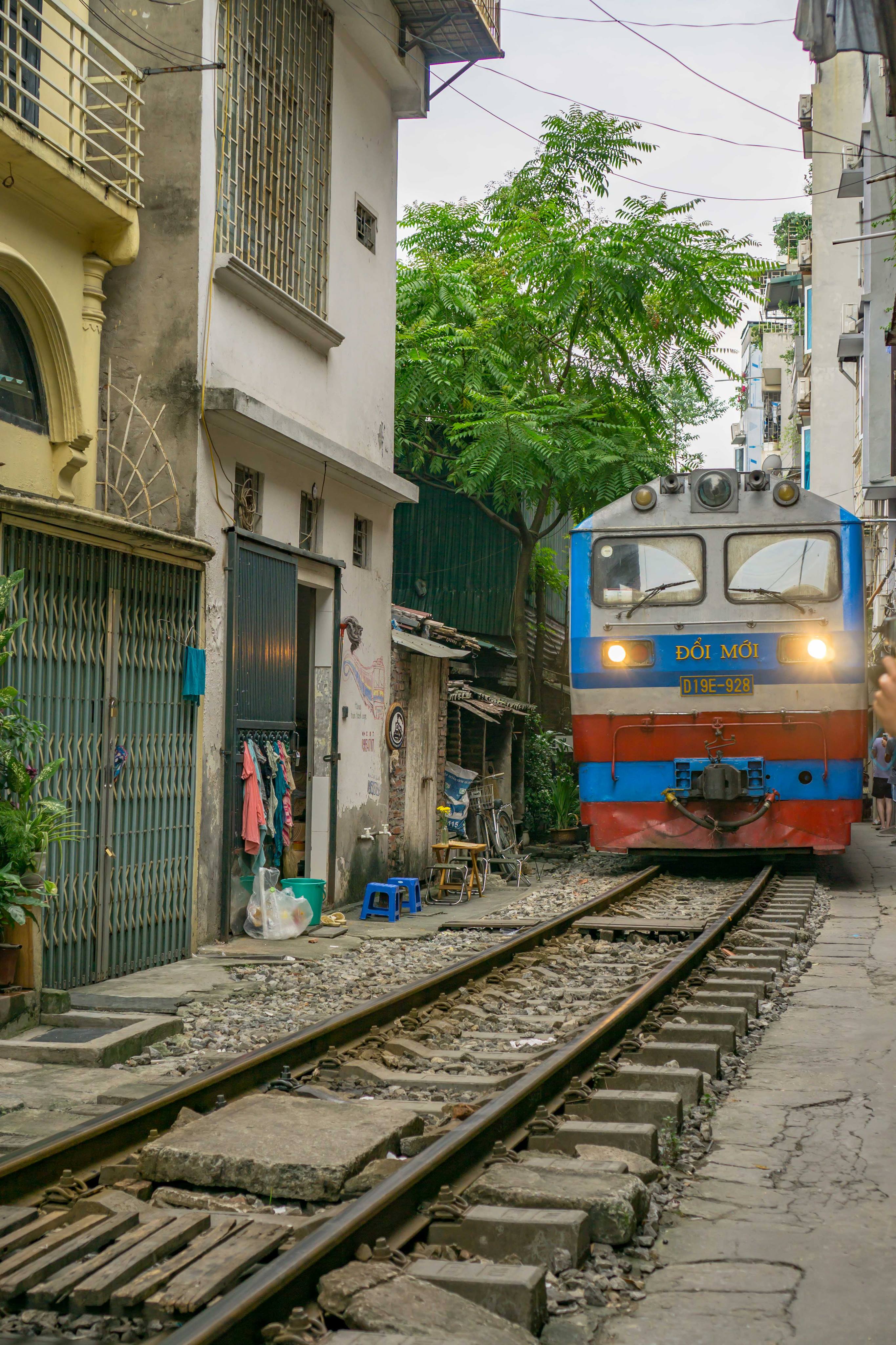
After the last coach passed, people still moved their cameras to catch the last frames of the train. Minutes later, they started to leave for other attractions in Hanoi. I sat down and waited for my friend. When she came, we chatted for a while and the next train came at 4:20 PM. Afterwards, she took me along the railways to Phung Hung street. On Phung Hung street, the railway was built higher and parallel to the main street, therefore it is just closed to one side of houses. The railway is on a long and thick wall created by large bricks. On the wall, people have made artistic paintings so that you can take cool photos. We ended our discovery of the train street by strolling to the Hanoi Old Quarter.
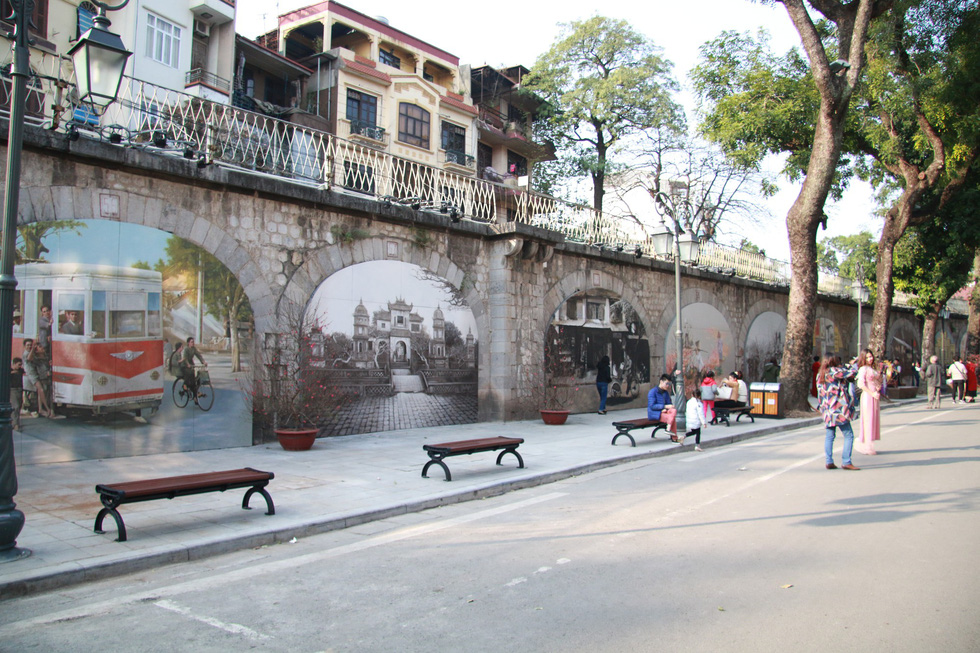
Where to Find the Hanoi Train Street?
The train street starts at Hanoi Railway Station, but you need to find your way to Nguyen Khuyen street to see it. You can stop at number 10 Nguyen Khuyen street and go along the railway to the northeast. If you want to approach the crowded train street, just do as I did, which is start your trip from number 10 Dien Bien Phu street. Then, follow the railway until you just see houses on one side only, that’s when you will reach Phung Hung street. From there, I suggest you go down to the main street and continue ahead until you see beautiful paintings on the wall. This is a popular spot for pictures.
From Dien Bien Phu street, you can see coffee shops on both sides of the railway and I highly recommend ordering a cup of egg coffee or a can of beer to enjoy, waiting for the train. On the board of the coffee shop, they not only write the menu of the shop, but also the times when the trains pass.
When to Visit this Train Street – Train times!
Now I will list out the time you can observe the train based on the coffee shop’s board. You should come 30 minutes early to take photos with the railway and the houses before the train comes.
From Monday to Friday: 6 AM, 7 PM, and 7:20 PM
Saturday and Sunday: 9:15 AM, 11:35 AM, 3:20 PM, 5:45 PM, 6:40 PM, 7:10 PM, and maybe 4:20 PM, when I saw that day the second time (maybe this is the new train and they haven’t updated the time yet).
Note: Please listen to the people giving directions when the train comes. Stand close the wall, behind the redline on the ground, and do not hold your phone or camera to far from your body for your safety. You can stand on the ground or go to the second floor of Tram Coffee. They built a top floor for visitors watching the train from above.
There are so many unique things to do and see in Hanoi. This is just one of many ways to spend a morning or afternoon getting to know local life. Maybe you should try to see this place soon before it’s changed!
Follow our 4U Trip to get more information about traveling in Hanoi as well as Vietnam. Here are some recommended articles for you:
Only Local People Know: Seven Distinct Areas in Hanoi
A Guide to Living in Hanoi as a Local
Places to Stay in Hanoi Old Quarter That’ll Help You Explore
If you enjoyed reading this article and would like some more fun info about what to see, do and eat (and a bunch of interesting cafes!) in Vietnam, follow us at the 4U Trip!
